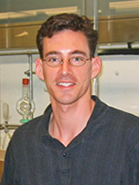Fall 2016 – GoMRI Researcher Interview with Dr. Scott Grayson
– NOVEMBER 28, 2016
(From Fall 2016 Newsletter) Dr. Scott Grayson from Tulane University answered a few questions about his RFP-II project, Development of Cost-Efficient and Concentration-Independent Dispersants for Improved Oil Spill Remediation.
1. Thank you for talking with us! Tell us a bit about your research. What are the goals of your project?
The goal of the research is to find a cheap and effective alternative to existing dispersants by pursuing a completely different approach. The vast majority of dispersants work by self-assembling amphiphiles into a form that stabilizes oil/water emulsions. However, such aggregates are inherently susceptible to disaggregation and destabilization. Therefore traditional dispersants have to fight a tug of war between the active species (assembled) and inactive species (individual molecules). The dilution that occurs in large bodies of water eventually disfavors the active species, though dispersants may exhibit stability in the short-term.
Our design is to construct a “single nanoparticle micelle” that is covalently tethered together in the active form and therefore will not disaggregate/destabilize, regardless of concentration, temperature, salt concentration, etc.
2. What is your background, and how did you get involved with this kind of work?
My background is in synthetic polymer chemistry with a focus on tuning molecular and nanoscale architecture. The concept of “unimolecule micelles” has been explored for delivery of drugs in vivo, but there has been little work that translates this concept to oil dispersants. I felt that combining the unimolecule micelle concept with a nanoparticle substrate, and applying these carriers for dispersant technologies, held much promise.
3. Can you talk a little more about what “unimolecule micelles” or “single nanoparticle micelles” are and how they work in this application?
When in a biphasic oil and water system, traditional amphiphiles can assemble at the interface of the two phases. This encourages the oil to break up into microdroplets which can then be more easily dispersed and undergo bioremediation. The amphiphiles effectively form a spherical shield around each oil microdroplet to stabilize them. However, when diluted below an inherent value, their critical micelle concentration (CMC), these dispersants are too depopulated to stabilize the micelles. As a result, the oil microdroplets can then recoalesce, potentially forming a slick. Because most oil spills occur in large bodies of water, dilution is an unavoidable problem.
The first “unimolecular micelles” were single-nanometer amphiphilic dendrimers. Their structure resembled a porous sphere with a hydrophobic interior and a hydrophilic surface. Detailed characterization verified that these structures could encapsulate hydrophobic compounds, yet unlike the simple amphiphiles used as surfactant and dispersants, these dendrimers had no critical micelle concentration. Because the three-dimensional structure of dendrimers is covalently bound together, they can encapsulate oil at any concentration, even under extreme dilution, without being destabilized. Although these dendrimers have many attractive features as dispersants, their single-nanometer size and low encapsulation volume makes them unrealistic for large-scale use. Our target for this research project was to make a much larger, cheaper analog, a “single nanoparticle micelle” that was approximately 100 nanometers in size and exhibited an encapsulation capacity (by weight) similar to traditional dispersants.
4. What are some of the most significant or exciting findings from your RFP-II project?
We are excited to be able to report that we have confirmed the proof of concept for this alternative design. By grafting amphiphilic polymers onto the surface of a nanoparticle, we have made “single nanoparticle micelles” that exhibit long-term stability when encapsulating oil, even at high dilution.
5. If funding were not an issue, what would you have added to your project?
Although we are excited to have demonstrated the concept of single nanoparticle dispersants, the meaningful long- term goal is finding a design that is cheap enough, non- toxic in marine environments, and sufficiently scalable to offer a competitive technology relative to existing dispersants. Though I believe this is possible, this is a very demanding goal that will require a rather significant investment of time, resources, and funding.
6. Your response to the previous question points to the challenges in further developing this technology for real-world application. What would the next steps be to make this possible?
The application of single nanoparticle micelles as dispersants is sufficiently different than existing commercial technologies that it could be consider a disrupting technology. Like all disrupting technologies, the first step is proving the concept, and I believe the research from our initial GoMRI support confirmed this. The next steps include: 1) demonstrating that it has a sufficiently superior performance with respect to existing technologies to justify its development (thorough side- by-side comparisons), 2) verifying that the technology is commercially feasible (scalability and price) and 3) confirming it can be designed to exhibit a reduced environmental impact relative to existing technologies (biodegradation and toxicity studies). These concerns are the focus of our continued research efforts.







